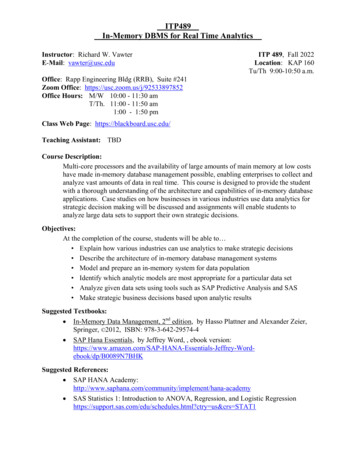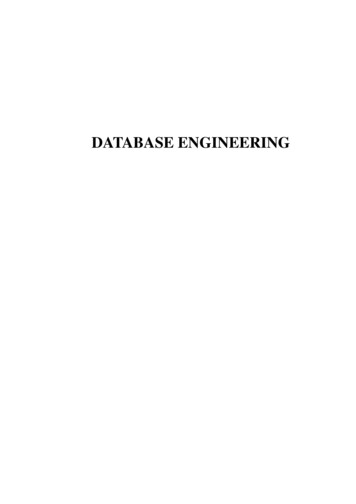
Transcription
ITP489In-Memory DBMS for Real Time AnalyticsInstructor: Richard W. VawterE-Mail: vawter@usc.eduITP 489, Fall 2022Location: KAP 160Tu/Th 9:00-10:50 a.m.Office: Rapp Engineering Bldg (RRB), Suite #241Zoom Office: https://usc.zoom.us/j/92533897852Office Hours: M/W 10:00 - 11:30 amT/Th. 11:00 - 11:50 am1:00 - 1:50 pmClass Web Page: https://blackboard.usc.edu/Teaching Assistant: TBDCourse Description:Multi-core processors and the availability of large amounts of main memory at low costshave made in-memory database management possible, enabling enterprises to collect andanalyze vast amounts of data in real time. This course is designed to provide the studentwith a thorough understanding of the architecture and capabilities of in-memory databaseapplications. Case studies on how businesses in various industries use data analytics forstrategic decision making will be discussed and assignments will enable students toanalyze large data sets to support their own strategic decisions.Objectives:At the completion of the course, students will be able to Explain how various industries can use analytics to make strategic decisions Describe the architecture of in-memory database management systems Model and prepare an in-memory system for data population Identify which analytic models are most appropriate for a particular data set Analyze given data sets using tools such as SAP Predictive Analysis and SAS Make strategic business decisions based upon analytic resultsSuggested Textbooks:x In-Memory Data Management, 2nd edition, by Hasso Plattner and Alexander Zeier,Springer, 2012, ISBN: 978-3-642-29574-4x SAP Hana Essentials, by Jeffrey Word, , ebook -Jeffrey-Wordebook/dp/B0089N7BHKSuggested References:x SAP HANA /hana-academyx SAS Statistics 1: Introduction to ANOVA, Regression, and Logistic ml?ctry us&crs STAT1
Computer Softwarex The software which you will be using throughout the semester is located on Vitirbi’sVirtual Desktop system. By enrolling in the ITP course, you automatically haveaccess to this system.x Instructions on how to log in to the Virtual Desktop system will be posted on thecourse Blackboard web page, within the “Course Information” module.Lab Assignments:x At the beginning of each week, Assignments will be available within the “WeeklyContent” section of the class Blackboard web site.x You are to turn in only the “Answer sheet” and “Summary” portion of the projectwrite-up as one document.x It is your responsibility to turn in the lab assignments by the deadlines indicated later inthis syllabus and verify that your assignment is available in the class “assignment box”.x If you can’t see or open your document, then neither can the grader!x Answers to the assignments will be posted on the class web page immediately after thedue date of the assignments for your review.Case Studiesx Three case studies will be assigned during the semester.x You are to read over the cases and type up a one-page analysis, double-spaced,explanation of the business situation, concerns, and possible suggested actions to take.x Case studies are to be submitted by the beginning of the lecture on the dates indicatedon the syllabus within the “Weekly Content” section of the class website (just as youdo for submitting your Assignments).Late Assignments and Case Write-upsx The Assignments link within the class web site “closes” after the due date and time.x You will no longer be able to submit your assignment and your assignment willbe considered late!x No late assignments will be accepted for credit. No excuses! So, please turn inyour assignments at the beginning of lecture on the dates indicated in this syllabus andnoted on the class web site !Handling Assignment Questions (in order of steps to be taken)1. Re-read the instructions carefully.2. Review the “Discussion Board” section of the class web site’s forum for otherstudents’ questions and comments or post a question yourself to begin the forum.3. And, of course, you are always welcome and encouraged to “stop by” during myoffice hours, or the TA’s, to discuss your questions.Final Project:x The final project will require that the student take all that he/she has learned duringthe semester through the readings, case studies, and assignments, and apply it to areal-world situation. At minimum, the student will import data into an in-memorydatabase system, model that data appropriately, and perform routine analytics. Thestudent’s recommendations presented in the conclusion of the final project must besupported by their analysis of the data.x No late final projects will be accepted for credit.
Examinations: Exams cover material from the reading assignments, lectures, and assignments.There will be two parts to the exam: c a written exam containing questions of the form:multiple choice, short answer, and short problem solving, and d a practical “lab” portionin which you will conduct exercises similar to those in the assignments. The exams willinclude material presented up to the date of the exam. The “Final” exam will becomprehensive and cover material presented throughout the semester, though emphasiswill be placed upon the latter part of the course.x Exam 1:x Exam 2:x Final Exam:Tue. Sept. 20Tue. Oct. 18Thurs. Dec. 89:00-10:50 a.m.9:00-10:50 a.m.11:00-1:00 p.m.KAP 160KAP 160KAP 160Note: Exams will be conducted in class during the times indicated above. No makeup exams will be offered nor will there be any changes made to the Final Examschedule as established by the University.Grading:Grading will be on a straight scale (as opposed to a class curve/average).94% and aboveA90% - 94% (not including 94%)A87% - 90% (not including 90%)B 83% - 87% (not including 87%)B80% - 83% (not including 83%)B77% - 80% (not including 80%)C etc.Final grades will be based strictly upon the total percentage earned. No exceptions!Nor, will any extra credit assignments be offered.Grades will be calculated by weighing the following work as described here:Average of Lab Assignment scores25%Exam #110%Exam #215%SAS Analysis Game5%Case write-ups10%Final Project15%Final Exam20%100%
Assignments, lectures, grades, discussion and all other coursematerials will be posted on http://blackboard.usc.edu . Pleasecheck the class website regularly.Class Schedule:ClassTopicWeek 1.Course OverviewAug. 23 x Discuss the SyllabusAug. 25 x Overview of In-MemoryDatabase SystemsSuggested ReadingAssignmentPlattner: Introduction Case #1 – Carolina's& Ch.1Health Care System, dueWord: Ch. 1next Tuesday beforeclass.Class notesWeek 2.Relational DatabasesAug. 30 x Discuss the Carolina'sHealth Care System caseSept. 1 x Overview of Relational DBdatabases & NormalizationAssignment #1 –Overview of RDBMS,due next Tuesday beforeclass.Week 3.HANA, In-Memory DBMS Plattner: Ch.4.1 –Ch.4.4Sept. 6 x Wrap up NormalizationBerg: Ch. 5.6Sept. 8 x Intro to In-MemoryDatabase Mgmt Systems & Word: Ch. 2the HANA In-MemoryComputing EngineAssignment #2 –Overview of In-MemoryDBMS, due nextTuesday before class.Case #2 – BasecampPricing, due nextThursday before class.Berg: Ch.6Week 4.Reporting & AnalysisSept. 13 x Using the HANA Studio forinitial data presentation andExcel for AnalysisSept. 15 x Discuss the BasecampPricing caseAssignment #3 – Introto Reporting, due nextMonday, before 5:00pm.Week 5.Data ProvisioningSept. 20 x Exam #1Sept. 22 x Importing and preparingdata for reporting andanalysisBerg: Ch.10Word: Ch. 6Berg: Ch.8Week 6.Data ModelingSept. 27 x Data Structures & theWord: Ch.7Modeling ProcessSept. 29 x Attribute & Analytic ViewsWeek 7.Oct. 4Oct. 6Data Modeling (continued)x Incorporating calculationscolumns in modeling viewsx Using Variables andDecision TablesAssignment #4 – DataProvisioning, due nextTuesday before class.Assignment #5 –DataModeling I, due nextTuesday before class.Berg: Ch.8 (cont.) Assignment #6 – DataWord: Ch.7 (cont.) Modeling II, due nextTuesday before class.Berg: Ch.8 (cont.) Assignment #7 –CalcuWeek 8.Data Modeling (continued)Oct. 11 x Creating Calculation Views Word: Ch.7 (cont.) ation Views, due nextOct. 13 x Fall Recess, no classMonday before 5 pm.
ClassTopicSuggested ReadingAssignmentClass notesCase #3 – EvaluatingCognitive Analytics, duenext Tuesday beforeclass.Assignment #8 –Predictive Analytics I,due next Thursday,before class.Class notesWeek 10.SAP Predictive AnalyticsOct. 25 x Discuss the EvaluatingCognitive Analytics caseOct. 27 x SAP’s Predictive AnalyticsTool (cont.) Apriori and K-MeansAnalysesAssignment #9 –Predictive Analytics II,due next Tuesday, beforeclass.Class notesWeek 11.SAS Enterprise MinerNov. 1 x Intro to Statistical AnalysisSystem (SAS) for AnalyticsNov. 3 x Data exploration & analysisusing SAS Enterprise MinerAssignment #10 – UsingSAS Enterprise Miner forAnalysis, due next Tues.,before class.Week 12.SAS Enterprise Miner (cont) Class notesNov. 8 x Apriori analyses in SASNov. 10 x K-Means analyses in SASAssignment #11 – Enterprise Miner II, due nextTuesday, before class.Week 13.SAS Enterprise Miner (cont) Class notesNov. 15 x Text Mining analysis usingSASNov. 17 x Return to Time SeriesAnalysesAssignment #12 – Enterprise Miner III, due nextTuesday, before class.Final Project available.Week 14. SAS Enterprise Miner (cont) Class notesNov. 22 x More on RegressionAnalyses and CumulativeNov. 24Lift and Gain Resultsx Thanksgiving Break – noclassContinue working onFinal Project.Week 9.Exam #2Oct. 18 x Exam #2Oct. 20 x Intro to SAP’s PredictiveAnalytics Tool Time Series, andRegression AnalysesWeek 15. SAS Analysis GameNov. 29 x SAS Analysis GameDec. 1 x Course ReviewWeek 16.Dec. 8Final Exam – 11:00 -1:00 pm--Final Project, due thisFriday, before 11:59 pm
Important University InformationStudents with Disabilities - (213) 740-0776Any Student requesting academic accommodations based on a disability is required toregister with Disability Services and Programs (DSP) each semester. A letter ofverification for approved accommodations can be obtained from DSP. Please be sure theletter is delivered to me (or to TA) as early in the semester as possible. DSP is located inSTU 301 and is open 8:30 a.m. - 2:00 p.m., Monday through Friday. http://dsp.usc.eduIncomplete and Missing GradesA grade of Incomplete (IN) “is assigned when work is no completed because ofdocumented illness or other ‘emergency’ occurring after the twelfth week of the semester(or 12th week equivalency for any course scheduled for less than 15 weeks).”A grade of Missing Grade (MG) “should only be assigned in unique or unusualsituations for those cases in which a student does not complete work for the coursebefore the semester ends. All missing grades must be resolved by the instructor throughthe Correction of Grade Process. One calendar year is allowed to resolve a MG. If anMG is not resolved [within] one year the grade is changed to [Unofficial Withdrawal]UW and will be calculated into the grade point average as zero grade points.Please refer to: /index.htmlAcademic ConductSharing of course materials outside of the learning environment - USC has a policy thatprohibits sharing of any synchronous and asynchronous course content outside of thelearning environment. SCampus Section 11.12(B):Distribution or use of notes or recordings based on university classes orlectures without the express permission of the instructor for purposes otherthan individual or group study is a violation of the USC Student ConductCode. This includes, but is not limited to, providing materials for distributionby services publishing class notes.Plagiarism – is a serious academic offense with serious consequencesPresenting someone else’s ideas as your own, either verbatim or recast in yourown words.Students who plagiarize the work of other students or provide material for another studentto copy, will receive zero points and will be referred to the Student Judicial Affairs andCommunity Standards (SJACS) board for further action. If SJACS determines the studentviolated the ethics codes, the student will receive an F in the course as suggested by theUniversity. This is non-negotiable!!Please familiarize yourself with the discussion of plagiarism in SCampus in Part B, Section11, “Behavior Violating University Standards” https://policy.usc.edu/scampus-part-b.Other forms of academic dishonesty are equally unacceptable. See additional informationin SCampus and university policies on scientific duct
Support Systems:Counseling and Mental Health - (213) 740-9355 – 24/7 on callhttps://studenthealth.usc.edu/counselingFree and confidential mental health treatment for students, including short-termpsychotherapy, group counseling, stress fitness workshops, and crisis intervention.National Suicide Prevention Lifeline - 1 (800) 273-8255 – 24/7 on callhttp://suicidepreventionlifeline.orgFree and confidential emotional support to people in suicidal crisis or emotional distress 24hours a day, 7 days a week.Relationship and Sexual Violence Prevention Services (RSVP) - (213) 740-9355(WELL),press “0” after hours – 24/7 on ee and confidential therapy services, workshops, and training for situations related togender-based harm.Office of Equity and Diversity (OED) - (213) 740-5086 Title IX – (213) 821-8298https://equity.usc.edu, http://titleix.usc.eduInformation about how to get help or help someone affected by harassment or discrimination,rights of protected classes, reporting options, and additional resources for students, faculty,staff, visitors, and applicants.Reporting Incidents of Bias or Harassment - (213) 740-5086 or (213) 821-8298https://usc-advocate.symplicity.com/care reportAvenue to report incidents of bias, hate crimes, and microaggressions to the Office of Equityand Diversity Title IX for appropriate investigation, supportive measures, and response.USC Campus Support and Intervention - (213) 821-4710https://campussupport.usc.eduAssists students and families in resolving complex personal, financial, and academic issuesadversely affecting their success as a student.Diversity at USC - (213) 740-2101https://diversity.usc.eduInformation on events, programs and training, the Provost’s Diversity and Inclusion Council,Diversity Liaisons for each academic school, chronology, participation, and variousresources for students.USC Emergency - UPC: (213) 740-4321, HSC: (323) 442-1000 – 24/7 on callhttp://dps.usc.edu, http://emergency.usc.eduEmergency assistance and avenue to report a crime. Latest updates regarding safety,including ways in which instruction will be continued if an officially declared emergencymakes travel to campus infeasible.USC Department of Public Safety - UPC: (213) 740-6000, HSC: (323) 442-120 – 24/7 oncallhttp://dps.usc.eduNon-emergency assistance or information.
SAS Enterprise Miner : x. Intro to Statistical Analysis System (SAS) for Analytics. x. Data exploration & analysis using SAS Enterprise Miner. Class notes . Assignment #10 - Using SAS Enterprise Miner for Analysis, due next Tues., before class. Week 12. Nov. 8 . Nov. 10 : SAS Enterprise Miner (cont) x. Apriori analyses in SAS . x. K-Means .










